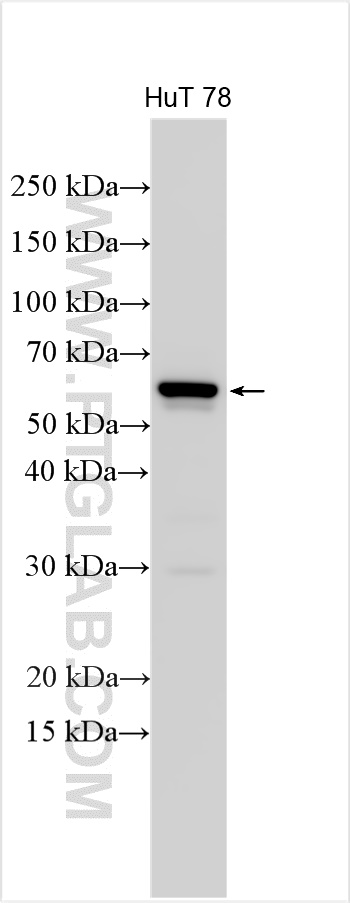Tested Applications
| Positive WB detected in | HuT 78 cells |
Recommended dilution
| Application | Dilution |
|---|---|
| Western Blot (WB) | WB : 1:500-1:2000 |
| It is recommended that this reagent should be titrated in each testing system to obtain optimal results. | |
| Sample-dependent, Check data in validation data gallery. | |
Product Information
31930-1-AP targets KIR2DL2 in WB, ELISA applications and shows reactivity with human samples.
| Tested Reactivity | human |
| Host / Isotype | Rabbit / IgG |
| Class | Polyclonal |
| Type | Antibody |
| Immunogen | KIR2DL2 fusion protein Ag35284 Predict reactive species |
| Full Name | killer cell immunoglobulin-like receptor, two domains, long cytoplasmic tail, 2 |
| Calculated Molecular Weight | 38 kDa |
| Observed Molecular Weight | 60,30 kDa |
| GenBank Accession Number | NM_014219 |
| Gene Symbol | KIR2DL2 |
| Gene ID (NCBI) | 3803 |
| RRID | AB_3670150 |
| Conjugate | Unconjugated |
| Form | Liquid |
| Purification Method | Antigen affinity Purification |
| UNIPROT ID | P43627 |
| Storage Buffer | PBS with 0.02% sodium azide and 50% glycerol , pH 7.3 |
| Storage Conditions | Store at -20°C. Stable for one year after shipment. Aliquoting is unnecessary for -20oC storage. 20ul sizes contain 0.1% BSA. |
Background Information
KIR2DL2 is one of killer cell immunoglobulin-like receptors, which are transmembrane glycoproteins expressed by natural killer cells and subsets of T cells. KIR proteins with the long cytoplasmic domain transduce inhibitory signals upon ligand binding via an immune tyrosine-based inhibitory motif (ITIM), while KIR proteins with the short cytoplasmic domain lack the ITIM motif and instead associate with the TYRO protein tyrosine kinase binding protein to transduce activating signals. The ligands for several KIR proteins are subsets of HLA class I molecules; thus, KIR proteins are thought to play an important role in regulation of the immune response.
Protocols
| Product Specific Protocols | |
|---|---|
| WB protocol for KIR2DL2 antibody 31930-1-AP | Download protocol |
| Standard Protocols | |
|---|---|
| Click here to view our Standard Protocols |



